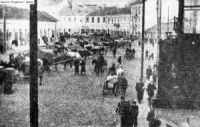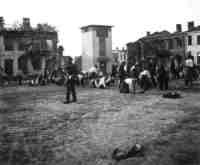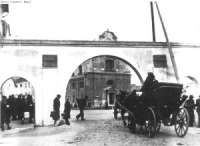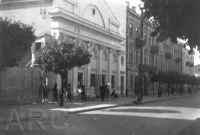 |
 |
 |
 |
 |
 |
 |
| Ghettos |
The city of Radom was occupied on 8 September 1939. Around 30,000 Jews (one third of Radom's population) fell into German hands. During the next months the Jewish community increased as several thousand Jews were sent to Radom, having been expelled from Poznan and Lodz provinces. In turn, 1,840 Radom Jews were deported to small towns in the environs.
At the IMT trial in Nürnberg, a Jewish resident of Radom, David Wajnapel, provided graphic testimony concerning conditions in the city following the German invasion:
A few weeks after the entry of the German troops into Radom, police and SS authorities arrived. Conditions became immediately worse. The house in the Zeromski St. where their headquarters were became a menace to the entire population. People who were walking in this street were dragged into the gateway and ill-treated by merciless beatings and by the staging of sadistic games. All SS officers, as well as the men, took part in this. Being a physician, I often had the opportunity to give medical help to seriously injured victims of the SS.
In December 1939 a Judenrat, headed by Josef Diamant, was established, and from 1 April 1941, a Jewish order service created, headed by Joachim Geiger, who had previously been in charge of the provision of Jewish forced labour in the city. The Radom Judenrat also served as the main Judenrat (Oberjudenrat) for the entire Radom district. On 1 July 1940, all property of the Jews in the region was transferred to the German administrative office (Treuhandstelle), headed by Felix Weinopfel.
Beginning in August 1940, around 2,000 Jews were deported to work camps in the Lublin district, where they were engaged in the construction of the "Otto Line", a series of anti-tank ditches and fortifications on the frontier between German and Soviet occupied Poland. Virtually all of these deportees perished. Hundreds more were sent to forced labour camps near Radom, in places such as Kruszyna, Jedlinsk, Lesiow, Dabrowa Kozlowska and Wolanow. Jews taken from Radom to the labour camp at Cieszanow would bitterly sing in Yiddish:
Work, brothers, work fast
If you don't, they'll lash your hide.
Not many of us will manage to last
Before long we'll all have died.
1,500 Radom Jews were deported to the small town of Busko in December 1940, to be followed by a further 1,000 in February 1941. As a result, the apartment density in the Jewish quarter of Busko rose to 20 per room and a typhus epidemic broke out. Following the various deportations to and from the city, in the spring of 1941, shortly before the establishment of the ghettos, there were approximately 32,000 Jews in Radom.
Between March and April 1941, the Germans established two ghettos: The large ghetto in the centre of Radom contained 27,000 people and the small ghetto in the Glinice suburb about 5,000.
On 7 April 1941, the ghettos were closed. No walls surrounded the ghettos, whose boundaries where indicated by surrounding housing. Although the Jews suffered from starvation, bad hygienic conditions and persecution by the SS and Gestapo, compared to most other ghettos, overall living conditions were relatively bearable. Smuggling food into the ghetto, however, could have deadly consequences and many paid with their lives for attempting to do so.
 |
| Radom Ghetto Street #1* |
 |
| Forced Jews on Market Place |
The small ghetto was liquidated on 5 August 1942. It was sealed off by the German security police and Ukrainians. The Jews were forced to assemble at a site near the railway line. There around 600 old people and children were shot, 800 men and 20 women chosen for forced labour and more than 6,000 people, including 2,000 selected from the large ghetto, deported to Treblinka, the newly established death camp. Those who tried to hide in the ghetto, were tracked down and shot on the spot.
The purge was led by SS-Untersturmführer Franz Schipers, together with SS-Hauptsturmführer Adolf Feucht and Erich Kapke, commander of the Ukrainians. Approximately 100 young men holding work permits were detailed to bury those who had been killed in mass graves dug next to the Lenz factory. When this task had been completed, they were ordered to gather the property of the deportees and to store it in the empty Korona factory.
Between 16 and 18 August, beginning with the southern section, the large ghetto was liquidated. 1,000 - 1,500 Jews who put up resistance or hid somewhere, were shot immediately. SS-Hauptscharführer Erich Schildt killed a group of children by using hand grenades. After a selection at the Stare Miasto (Old Town) Square 4,000 Jews were assigned to forced labour in two camps, established at Szwarlikowska Street and Szkolna Street, the latter becoming the Szkolna Street camp, a subcamp of Majdanek in 1944.
18,000 others, not selected for slave labour, were deported to Treblinka and death. David Wajnapel:
In August 1942, the so-called 'deportation' took place. The ghettos were surrounded by many SS units who occupied all the street exits. People were driven out to the streets and those who ran were fired at. Sick people at home or in hospitals were shot on the spot, among others also the sick people who were in the hospital where I was working as a doctor
After the 'deportation', the remaining group of people were massed in a few narrow lanes and we came under the exclusive rule of the SS and became the private property of the SS who used to hire us out for payment to various firms. I know that these payments were credited to a special SS account at the Radom Bank Emisyjny. We were visited by SS men only. Executions carried out by the SS in the ghetto itself were a frequent occurrence.
Another witness before the IMT, Mojzesz Goldberg, stated:
I lived in Radom and worked from June 1942 to July 1944, for the Waffen-SS at three places: the SS Veterinary Reinforcement Detachment, Koscinski Street, the Garrison Administration of the Waffen-SS, Planty 11, and the Building Directorate of the Waffen-SS, Slowacki Street 27.
As I worked so long for the SS, I know the names and faces of all the officers and N.C.O.s of the above named detachments of the Waffen-SS very well. At the head of the SS Veterinary Reinforcement Detachment were Sturmbannführer Dr Held and Hauptsturmführer Schreiner; at the head of the garrison administration there was Obersturmführer Grabau [at present (1946) in Dachau Camp] and at the head of the building directorate, Oberscharführer Seiler.
All the persons mentioned took a direct part, together with their companies, in carrying out the expulsions in Radom on 5th, 16th, and 17th August 1942, during which some thousands of people were shot on the spot. I know that the SS Veterinary Reinforcement companies went into the provincial towns to carry out the 'expulsions' of the Jews. I heard individual soldiers boasting about the number of Jews they had killed. I know from their own stories that these same companies participated in the actions against Polish partisans and also set the surrounding Polish villages on fire."
Dr Ludwig Fesman was appointed as the new head of the Judenrat, a position he held until January 1943, when he was deported to Auschwitz. Dr Nachum Szenderowicz succeeded him until May 1943, at which time the remaining members of the Judenrat were transported to the labour camp at Wolanow, where they all perished. The commandant of the Jewish police, Leon Sytner, was appointed as the last head of the Judenrat. By this time the ghettos were established slave labour camps under SS supervision and commanded by Franz Schipers. The main place of work was the armaments factory Wytwornia where approximately 1,000 Jews were employed. Another group, consisting mainly of women, worked in the Korona warehouses, sorting the belongings of those who had been killed. Other small workshops were also opened.
 |
| Main Entrance Gate to the Ghetto * |
 |
| Radom Ghetto Street #2 |
In January 1943, 1,500 others were transported to Treblinka. In November 1943, the Szwarlikowska camp was closed, the last inmates being forced to march to the Szkolna camp. 100 women, children and old men who were unable to work were shot.
In the Szkolna camp around 3,000 men, women, and children were forced to work for the Germans. When the Szkolna camp was evacuated on 26 July 1944, the former inmates of Kolejowa 18 camp (supply depot of SS and Gestapo, a branch of the Szkolna camp) were forced to march for eight days to Tomaszow Mazowiecki, where the men were separated from the women. Among the Radom prisoners were the last Jewish prisoners from Majdanek and the Gestapo prison in the Lublin castle. The women were taken to jail, and the men were taken to a large factory with no sanitation facilities, where they remained for two to three days. From Tomaszow Lubelski, they were all loaded onto cattle cars for Auschwitz.
David Wajnapel testified:
On 21st March 1943, there took place throughout the whole district the so-called 'action against the intelligentsia', which action, as I know, was decided upon in an SS and Police Leaders' meeting in Radom. In Radom alone about 200 people were shot at that time; among others, my parents, my brother and his nine-months-old child met their deaths.
On 9th November of the same year all Jewish children up to 12 years of age as well as the old and sick were gathered from Radom and from camps situated near Radom, and shot in the Biala Street in Radom. Both SS officers and other ranks participated in this. From March 1943, I stayed 18 months in Blizyn Camp. The camp was entirely under the SS and the Radom Police Chief's control. Its commandant was Untersturmführer Paul Nell. The guards were composed of SS privates and N.C.O.s. The foremen were Waffen-SS-men who had been wounded at the front. Both behaved in an inhuman manner by beating and ill-treating us. Shootings of people were frequent occurrences. Originally sentences were passed by the SS and Police Führer, later on by the camp commandant. The SS other ranks knew very well about the bloody deeds which were committed by the SS in Poland, in particular they told me personally about mass murders of Jews in Majdanek (Aktion Erntefest), in November 1943). This fact was no secret. It was common knowledge among the civil population as well as among the lowest-ranking SS men.
When the camp was taken over by the Majdanek concentration camp, new guards were sent to our camp, but there was no difference between them and the previous ones. In July 1944, the whole camp, including myself, was sent to Auschwitz camp, which could be entered only by SS-men. The conditions of this camp are well known. I escaped during the evacuation of this camp into Germany. On the way, the SS escort machine gunned exhausted prisoners and later on the rest of the marching column. Several hundred people were killed at that time."
A real resistance organization did not exist in the Radom ghetto but some underground groups were operational. Their members escaped from the two ghettos, became partisans and fought against the Germans. Most of them were killed.
 |
| 30,000 Jews lived in the ghetto |
Photos: GFH *
Sources:
Encyclopedia of the Holocaust
Gutman, Israel, ed. Encyclopedia of the Holocaust, Macmillan Publishing Company, New York, 1990
Gilbert, Martin. The Holocaust The Jewish Tragedy, William Collins Sons & Co. Limited, London, 1986
Dawidowicz Lucy S. The War Against the Jews, Bantam Books, New York, 1979
Transcripts of the IMT trial on: Avalon Project at Yale Law School - www.yale.edu/
© ARC 2005